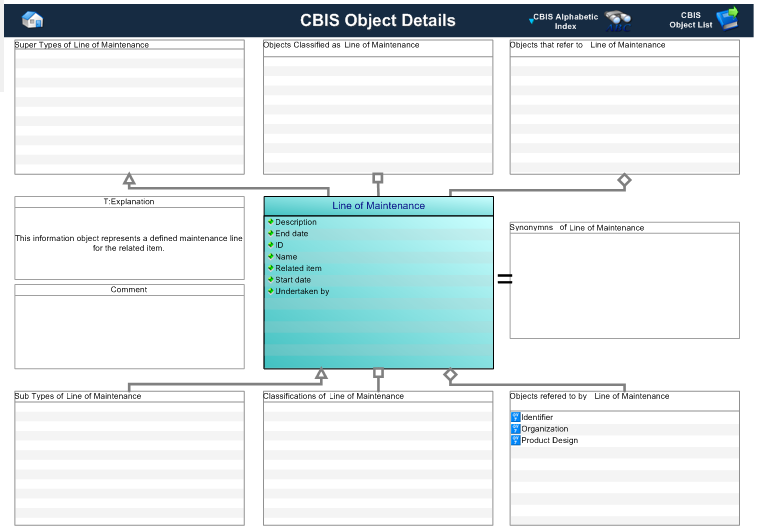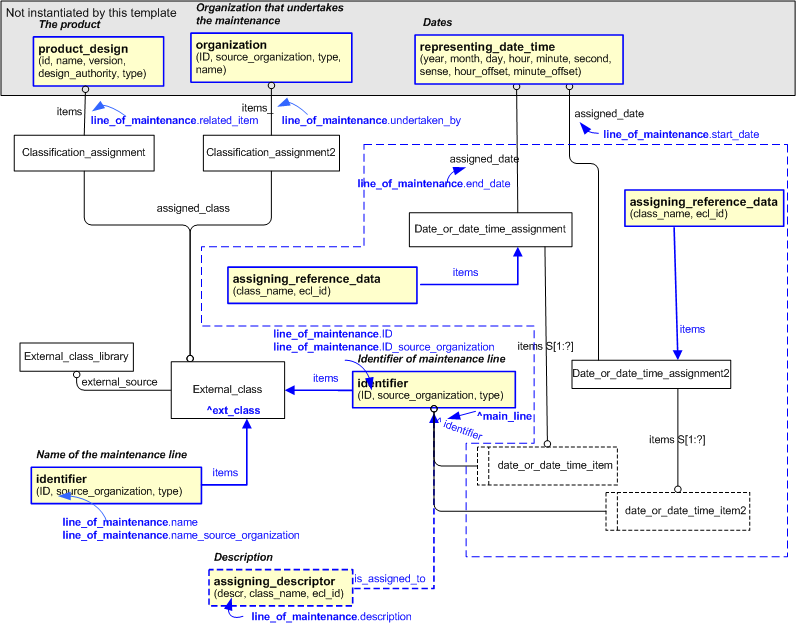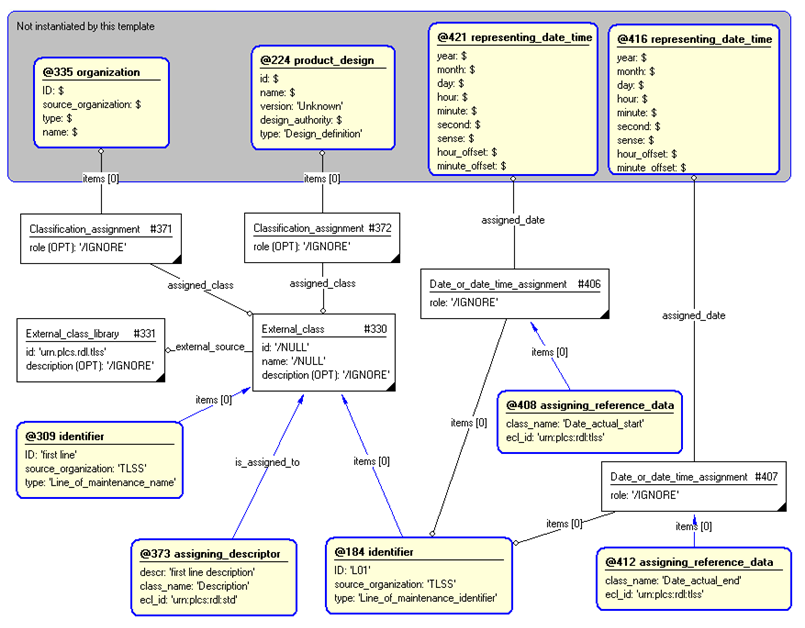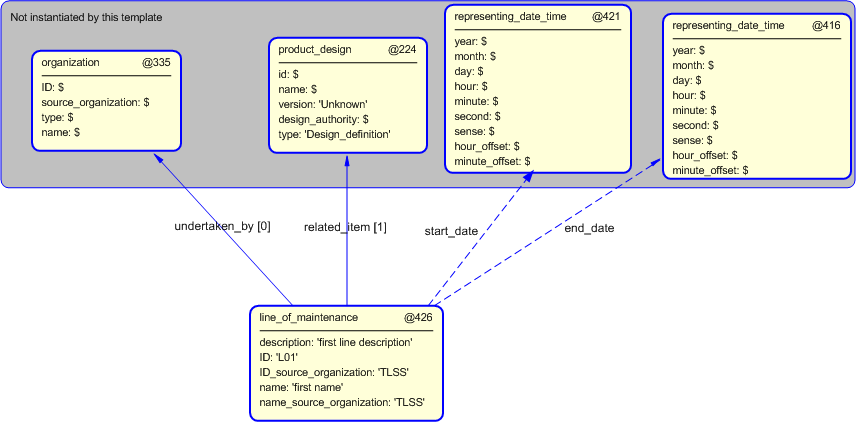Template:— line_of_maintenance (line_of_main)
Context:— UK_Defence |
Date: 2009/04/17 10:01:11
Revision: 1.3
|
This section specifies the template line_of_maintenance.
NOTE
The template has been defined in the context of
UK_Defence.
Refer to the business context for details of related templates.
NOTE
An explanation of a template and the associated instantiation path is
provided in the
Template overview
section.
This template describes how to represent a defined maintenance line for the related item.
The line_of_maintenance business object is used by those UK_Defence Data Exchange
Specifications that require information about the defined maintenance line for the related item.
Figure 1 — Graphical Representation for Business Object Line of Maintenance
Line of Maintenance:
The definition of an Line of Maintenance object is:
Data about the maintenance line for the related item.
|
Attribute name
|
Attribute description
|
Attribute type
|
Optionality
|
| Description |
This is the description of the maintenance line. |
Intrinsic |
Optional |
| End Date |
This is the date and time on which the maintenance line can be considered to have become inoperative. |
Intrinsic |
Optional |
| ID |
This is the identifier of the maintenance line. |
Identifier |
Mandatory |
| Name |
This is the name of the maintenance line.
Examples (from DEF STAN 00-60, DED 277, operations/maintenance level):
"operator crew unit crew",
"first line",
"second line",
"second line close support",
"second line general support",
"second line regional static",
"embarked second line",
"third line",
"fourth line",
"specialized repair activity".
|
Intrinsic |
Mandatory |
| Related Item |
This is the reference to the item for which the maintenance line is defined. |
Product Design |
Mandatory |
| Start Date |
This is the date and time on which the maintenance line can be considered to be operative. |
Intrinsic |
Optional |
| Undertaken By |
This is the reference organization that undertakes maintenance at the related line for the related product design. |
Organization |
Mandatory |
Table 1 — Line_of_maintenance attribute details
The EXPRESS-G diagram in
Figure
2
shows the templates and EXPRESS entities that are required
to represent the template
"line_of_maintenance".
The text highlighted in blue shows the template parameters.
Figure 2 — An EXPRESS-G representation of the Information model for line_of_maintenance
The graphic for the template to be used in other EXPRESS-G diagrams
is shown in Figure
3
below.
Figure 3 — The graphical representation of the line_of_maintenance template
The following input parameters are defined for this template:
This is the description of the maintenance line.
The date and time on which the maintenance line can be considered to have become inoperative.
Current identifier of the maintenance line.
The organization that created the maintenance line identifier. Additionally
a Person or Information System could be defined when either of these are the source; see Identifier template characterizations
Current name of the maintenance line.
The organization that created the maintenance line name. Additionally
a Person or Information System could be defined when either of these are the source; see Identifier template characterizations
The date and time on which the maintenance line can be considered to have become operative.
The reference organization that undertakes maintenance at the related line for the related product design.
The following reference parameters are defined for this template:
%^target = $line_of_maintenance.main_line%
Allow the
External_class
entity instantiated in this path to be referenced when this template is used.
Note: The
External_class
entity can be referenced in a template path by:
%^target = $line_of_maintenance.ext_class%
The following parameter combinations specify a uniqueness constraint:
Unique constraint: Unique line of maintenance
Any given identifier and name shall only be assigned to a maintenance line once.
The instantiation path shown below specifies the entities that are to be
instantiated by the template.
A description of templates and the syntax for the instantiation path is
provided in the
Templates Help/Information section.
External_class-- Mark the External_class entity as referable when this template is used. -- In other words, bind the External_class instance to the reference -- parameter ext_class %^ext_class =
External_class%
External_class.id = '/NULL'
External_class.description = '/IGNORE'
External_class.name = '/NULL'
External_class.external_source ->
External_class_libraryExternal_class_library.id = 'urn:plcs:rdl:uk_defence'
External_class_library.description = '/IGNORE'
/
identifier(
ID=@ID,
source_organization=@ID_source_organization,
type='Organization_identification_code',
items=^ext_class)/
%^main_line = $identifier.identifier%
-- [optional Description] /
assigning_descriptor(
descr=@description,
class_name='Description',
ecl_id='urn:plcs:rdl:uk_defence',
is_assigned_to=^ext_class)/
-- [optional end date] Date_or_date_time_assignmentDate_or_date_time_assignment.items ->
^main_line
Date_or_date_time_assignment.assigned_date ->
@end_date%^end_date_time =
Date_or_date_time_assignment%
/
assigning_reference_data(
items=^end_date_time,
class_name='Date_actual_end',
ecl_id='urn:plcs:rdl:uk_defence')/
/
identifier(
ID=@name,
source_organization=@name_source_organization,
type='Organization_name',
items=^ext_class)/
-- Create the Classification_assignment entity Classification_assignmentClassification_assignment.role = '/IGNORE'
Classification_assignment.items ->
@related_itemClassification_assignment.assigned_class ->
^ext_class
-- Create the Classification_assignment entity Classification_assignmentClassification_assignment.role = '/IGNORE'
Classification_assignment.items ->
@undertaken_byClassification_assignment.assigned_class ->
^ext_class
-- [optional start date] Date_or_date_time_assignmentDate_or_date_time_assignment.items ->
^main_line
Date_or_date_time_assignment.assigned_date ->
@start_date%^start_date_time =
Date_or_date_time_assignment%
/
assigning_reference_data(
items=^start_date_time,
class_name='Date_actual_start',
ecl_id='urn:plcs:rdl:uk_defence')/
The following entities are instantiated with attributes as specified:
The instance diagram in Figure
4
shows an example of the EXPRESS entities and templates that are instantiated by the template:
/line_of_maintenance(description='first line description', end_date='@416', items='@224', ID='L01', ID_source_organization='UK_Defence', name='first line', name_source_organization='UK_Defence', related_item='@224', start_date='@421', undertaken_by='@335')/
(an illustration of the consolidated line_of_maintenance template is shown in
Figure
5 below.)
Figure 4 — Entities instantiated by line_of_maintenance template
The instance diagram in
Figure
5
shows the graphic symbol for the template that is to be
used in other instance diagrams. The example template is:
/line_of_maintenance(description='first line description', end_date='@416', items='@224', ID='L01', ID_source_organization='UK_Defence', name='first line', name_source_organization='UK_Defence', related_item='@224', start_date='@421', undertaken_by='@335')/
Figure 5 — Instantiation of line_of_maintenance template
Characterizations
No common characterizations of the template
line_of_maintenance
have been identified. However, the ISO 10303-239 EXPRESS model
may enable other assignments to the entities instantiated by the template.




